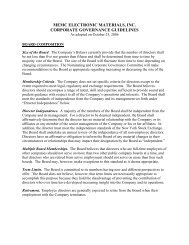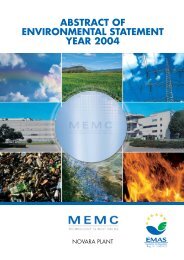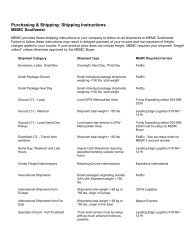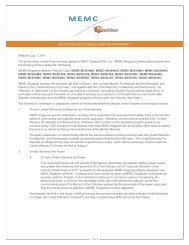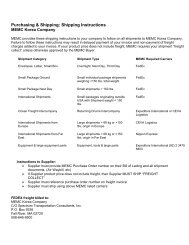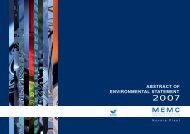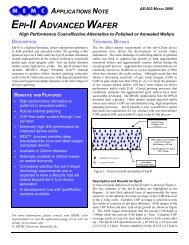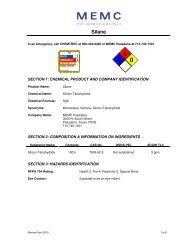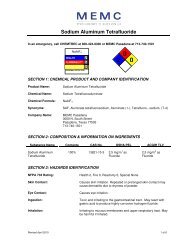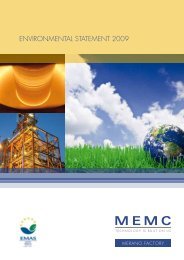BUILDING ON THE PAST, READY FOR THE FUTURE: - MEMC
BUILDING ON THE PAST, READY FOR THE FUTURE: - MEMC
BUILDING ON THE PAST, READY FOR THE FUTURE: - MEMC
You also want an ePaper? Increase the reach of your titles
YUMPU automatically turns print PDFs into web optimized ePapers that Google loves.
Moore’S lAW<br />
Monsanto grew and<br />
acquired other companies.<br />
One of particular note was<br />
the Thomas & Hochwalt<br />
Laboratories in Dayton, Ohio, which<br />
Monsanto purchased in 1936. It was<br />
in Dayton that several of <strong>MEMC</strong>’s<br />
pioneers, Drs. Robert Walsh and<br />
Wallene Derby among them, got their<br />
start performing research on gallium<br />
arsenide for the manufacture of light<br />
emitting diodes (LED). Eventually, the<br />
Dayton lab relocated to Monsanto’s<br />
world headquarters in St. Louis,<br />
Missouri.<br />
In 1959, Monsanto broke ground at<br />
the St. Peters plant site cementing its<br />
commitment to the silicon wafer industry.<br />
The developments in silicon technology<br />
that took place at the St. Peters plant in the<br />
coming years would form the foundation<br />
for a technological explosion that continues<br />
to this day.<br />
Sources:<br />
http://www.pbs.org/transistor/album1/index.html<br />
http://www.xnumber.com/xnumber/kilby.htm<br />
http://www.computerhistory.org<br />
www.semi.org/en/P043595<br />
Gordon Moore, for whom Moore’s Law is named, started his career at Shockley Labs in 1956<br />
and went on to co-found Fairchild Semiconductor in 1957 and Intel Corporation in 1968. widely<br />
known for his 1965 prediction that the number of transistors on a computer chip would double<br />
approximately every year, he refers to this prediction as “a wild extrapolation of very little<br />
data.” Though his original prediction was only for the ensuing ten-year period, he reviewed it<br />
in 1975 and, based on technological advancements at that time, adjusted it to doubling every<br />
twenty-four months and extended it for another ten years. Asked about the future durability of<br />
Moore’s Law, he said, “We’re getting pretty close to molecular dimensions in the devices we’re<br />
making now, and that’s going to become a fundamental limit in how we can continue to shrink<br />
things. So, it’s going to change after another two or three process generations—I don’t know<br />
exactly when.”<br />
The Birth of Technology 13



